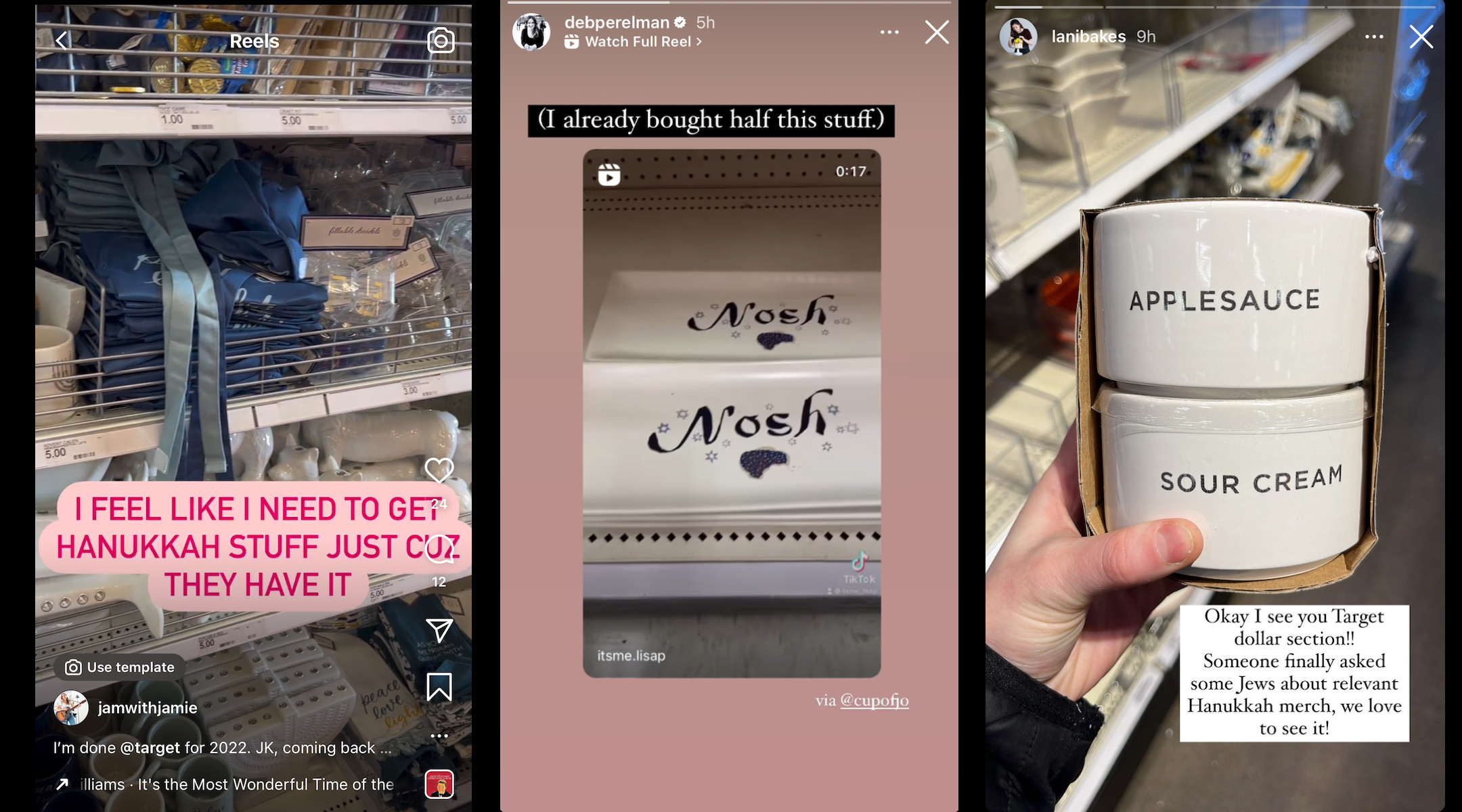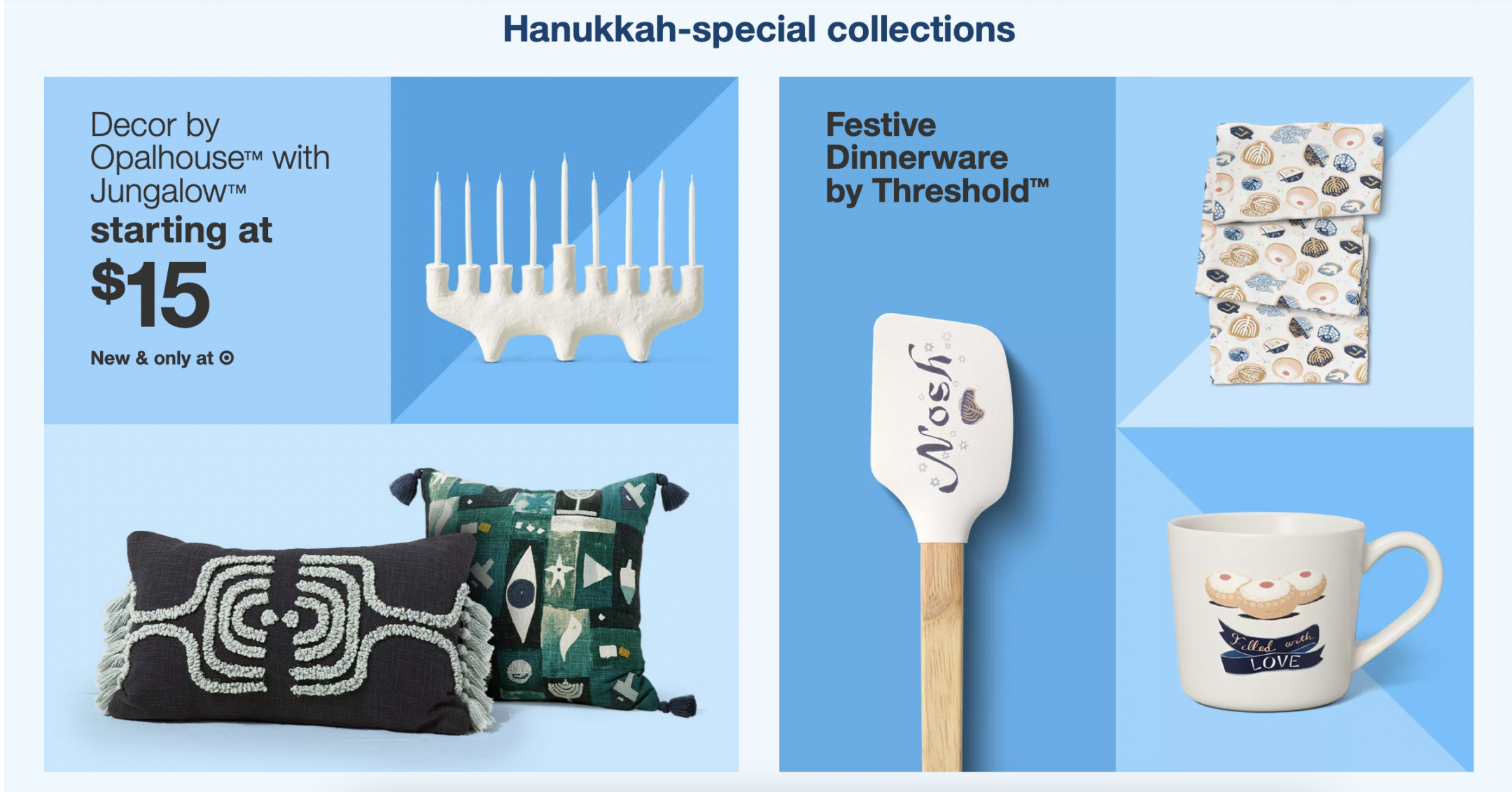The Hanukkah merch market has exploded. But are Jews feeling more represented?
Many say the collections make them feel included. Retailers are counting on them to spend big

Target’s array of Hanukkah mugs represent just a small swath of the national retailer’s 2022 Hanukkah collection. (Philissa Cramer)
(JTA) — It was early November when Nicholas Wymer-Santiago walked into his local Target in Austin, Texas, and realized it was beginning to feel a lot like Hanukkah.
Instead of an endcap with a limited array of Hanukkah basics, as he had seen in past years, there stretched out a whole aisle of holiday products: pillows; dreidel-shaped pet toys; window decals; menorahs in the shape of lions, corgis and whales; and so much more. Even the $5-and-under impulse-buys section filled with seasonal products had a supply of Hanukkah goods, including a Star of David-shaped bowl and a set of dishes labeled “sour cream” and “applesauce.”
“In a good way, it was overwhelming at first, because there’s so much and I kind of want to buy it all,” Wymer-Santiago recalled feeling as he stood in the holiday section, looking up at a large photograph of a Hanukkah celebration alongside others showcasing Christmas.
The higher education administrator at the University of Texas decided to limit himself, at first taking home just a tea towel and a matching mug printed with a Hanukkah motif.
“And then I came back twice, maybe three times and each time I bought more and more items that I know I probably don’t need,” he said. “I think I’ve just had so much excitement about the novelty of it all, and having the ability to purchase these items, many of which I’ve never seen before.”
Wymer-Santiago is hardly alone in loading his cart with Hanukkah merchandise. Across the United States, big-box stores appear to be stocking more Hanukkah products than ever — and while off-color items such as Hanukkah gnomes and “Oy to the World” dish towels have raised eyebrows, the real story might be that American retailers have decked their shelves with menorahs, tableware and other items that are appropriate, affordable and often downright tasteful.
For many American Jews, the result is a sense of inclusion at a time of unease — although some are wrestling with what it means to have access to a fast-fashion form of Judaica.
“It is very exciting to go into Target or Michaels or a Walmart and to see Hanukkah merchandise,” said Ariel Scheer Stein, an influencer who shares crafting and holiday content for Jewish families on Instagram, where she has more than 20,000 followers.

“The feeling is almost like pride and like we’re being seen and represented,” Stein added. “In a sea of Christmas … it feels really great, even if it’s a much smaller representation, that the Jewish holiday is there also and the Jewish community is being acknowledged and represented.”
The idea that retailers have stocked up on Hanukkah goods to make Jews feel represented is tempting, but it’s probably not the only reason for a shift in the market, according to Russell Winer, deputy chair of the marketing department at New York University’s Stern School of Business. He said that while an endcap — the small set of shelves at the end of an aisle — might sometimes be given over for symbolic purposes, the devotion of an entire aisle at the busiest time of the year is purely a business decision.
“These stores are very sophisticated in what they put in them,” Winer said. “They’re not going to put stuff on the shelves, especially at the holidays, if they don’t think they’re going to sell.”
There are signs that the Hanukkah market might be much wider than the proportion of Americans who identify as Jewish, 2.5%, would suggest. Numerator, a respected consumer trends polling firm, found in a survey of 11,000 consumers conducted in January 2022 that 14% of respondents said they were “definitely” or “probably” celebrating Hanukkah this year, compared to 96% for Christmas. More than half of the Hanukkah celebrants said they expected to spend more than $50 on the holiday — suggesting that retailers can expect hundreds of millions of dollars in Hanukkah spending this year.
Part of that marketplace is the growing number of families in which Hanukkah is celebrated alongside other holidays, usually Christmas. Most American Jews who have married in the last decade have done so to people who are not Jewish, according to the 2020 Pew study of American Jews; most of them say they are raising their children exclusively or partly as Jews. They may want to have products that allow Hanukkah to share the stage equitably with the other celebrations in their family.
“I’m not terribly surprised from a cultural standpoint that there’s more merchandise,” said Winer, who is Jewish. He said he and his wife had purchased Hanukkah stockings for their grandchildren, who are being raised in two faith traditions. (Evangelical Christians and Messianics, those who adopt Jewish practices while believing in the divinity of Jesus, also represent an emerging market for Jewish ritual objects.)
Stein offered another theory to explain the uptick in interest in Hanukkah products: the fact that social media and Zoom meetings have made home lives more transparent than ever.
“The communal sharing of lives, whether you’re an influencer or even my friends on Facebook showing what their display is this year or taking a picture of a recipe they were really proud of, making latkes from scratch — there’s just more visibility than there has been in the past,” she said. “And that’s probably a factor.”
Whatever the reasons, shoppers are noticing. Like Stein and countless other Jewish influencers, Rabbi Yael Buechler, a devoted observer of Jewish consumer trends, has offered tours of Hanukkah merchandise to her social media followers. Wearing Hanukkah pajamas that she designed and sells, Buechler has posted 14 videos to TikTok showcasing the Hanukkah collections of national retailers and assigns each store a “yay” or “nay” based on several metrics, including whether items display accurate Hebrew or appear to be generic blue-and-white items being passed off as made for the holiday. The videos, which have been viewed hundreds of thousands of times, have given her a broad view of what’s available to the Hanukkah consumer.
@midrashmanicures Welcome to the second installment of Hanukkah merch: YAY or NAY? ?.@target edition ✨.Items were rated by:?If the product was beyond blue & white☑️ Correct Hebrew ? Whether the Hanukkiyah was kosher? If the Hanukkah pun was good?Whether animal was Hanukkah punnable (i.e. Menorasaurus) .#hanukkahiscoming #hanukkahfails #hanukkahcountdown #hanukkahyayornay #yayornay #hanukkah2022 #targetfinds #hanukkahpresents #hanukkahpjs #hanukkahgifts #hanukkahcheck #chanukah2022 ♬ Oh Hanukkah - Maccabeats
“I see a lot more products this year than any other year,” said Buechler, who works at a Jewish school outside New York City. “I see a lot of new prints. I see more creativity in the market. I see more humor in the market.”
Like Wymer-Santiago, Buechler said Target, which has 2,000 locations across the United States, stood out as offering the widest array of products and the lowest proportion of “fails,” or products that miss the mark religiously, culturally or aesthetically.
“They have really stepped it up,” Buechler said. “Target also carries the Nickelodeon ‘Rugrats’ Hanukkah sweatshirts that are just brilliant. … I would definitely say they get the biggest ‘yay’ for this year.”
Target, which has a track record of using inclusive imagery in its advertisements and in-store promotions, declined to answer questions about its offerings, including how much bigger its Hanukkah collection is this year than in the past and how widely the products for Jewish buyers have been distributed. But a spokesperson said the feeling Wymer-Santiago and Stein described after visiting their local stores is exactly what the company is trying to cultivate.
“Target is committed to creating an inclusive guest experience in which all guests feel represented,” the spokesperson wrote in an email. The spokesperson noted that Target’s Hanukkah assortment “was developed in collaboration with Jewish team members and input from our Jewish employee resource group” and crosses several of the retailer’s in-house brands.
One of those lines, Opalhouse by Jungalow, was created by a Jewish artist, Justina Blakeney. Last year, Blakeney’s first Hanukkah collection included plates and pillows, as well as a gold menorah shaped like a dove. This year, Blakeney added new pillow designs and a clay menorah.

“If I could go back in time and tell elementary-school-aged Justina (or ‘Tina’ as I was called back then) that I would have a chance to design a Hanukkah collection for Target, I would have lost my mind,” she wrote in an October blog post revealing the collection.
Hanukkah goods have always been widely available through Jewish merchandisers and at synagogue bazaars — but those products have been available only to people who already engaged in Jewish communities. Amazon and other online retailers have increased access, but only for people who are hunting for Hanukkah supplies. A Hanukkah aisle at Target, in contrast, reaches the many Jews who may not already have robust holiday traditions.
Stein, who said she particularly regretted not snapping up a marble dreidel sculpture that quickly sold out at Target, said she saw only benefits in promoting major retailers’ Hanukkah offerings, even if doing so has made her something of an unpaid advertiser at times.
“Right now, especially with the rise of antisemitism, if there are ways that we can spur Jewish joy — and for me, that’s by sharing and inspiring people with different kinds of Hanukkah merch and home decor and jewelry — I think that’s great,” she said.
Not everyone is thrilled by the shift in the marketplace. The sweeping Hanukkah displays are drawing criticism from those who have long lamented that the American primacy of Christmas has caused Jews to focus too much on a minor holiday, while leaving holidays with more religious significance relatively uncelebrated.
“I think: What would it feel like to see a giant Shavuot display?” Wymer-Santiago said.
The fast-fashion aspect of the big-box retailers’ offerings, many of which are imported from China, also raises concerns about whether easy access to trendy Judaica comes at environmental and cultural costs.
“How about we don’t extract fossil fuels to make crap that no one needs and that makes Jewish communities less distinctive?” asked Dan Friedman, a writer and longtime climate activist, though he emphasized that systemic change, rather than tweaks to purchasing decisions by Jewish consumers, is needed to avert climate catastrophe.
For Buechler and others, the benefits of a mass-market Hanukkah merchandise boom outweigh any possible drawbacks.
“As a rabbi, I am all for anything that will make Hanukkah celebrations more engaging and potentially lengthen a family celebration,” said Buechler, who said her own collection had outgrown the four tubs it occupied several months ago, and that one of her favorite purchases was of a Hanukkah sweater for lizards that she bought for a friend’s guinea pig.
“I really do believe that owning different kinds of Hanukkah merch, whether apparel or otherwise, will increase the likelihood that a family will celebrate with friends with family for more nights than they would have last year,” she added.

Wymer-Santiago plans to celebrate the holiday with his family in Ohio, meaning that he will be leaving behind much of this year’s Target haul in his Austin apartment: the device that makes dreidel-shaped waffles, the window decals that advertise the holiday to passersby, the giant dreidel-shaped jar that he has filled with, well, dreidels. He said he planned to make room in his suitcase for at least one item: a $5 menorah that reminds him of his dog.
Wymer-Santiago said a piece of him worried that Target was taking advantage of his excitement about Jewish representation, the way it has been criticized for doing around LGBTQ Pride celebrations, to sell him stuff he doesn’t need.
“Every time I buy something from Target in general, but definitely for Hanukkah, I think about this,” he said. “But then I think: This thing is so cute. And I just need it.”
This article originally appeared on JTA.org.
A message from our Publisher & CEO Rachel Fishman Feddersen

I hope you appreciated this article. Before you go, I’d like to ask you to please support the Forward’s award-winning, nonprofit journalism so that we can be prepared for whatever news 2025 brings.
At a time when other newsrooms are closing or cutting back, the Forward has removed its paywall and invested additional resources to report on the ground from Israel and around the U.S. on the impact of the war, rising antisemitism and polarized discourse.
Readers like you make it all possible. Support our work by becoming a Forward Member and connect with our journalism and your community.
— Rachel Fishman Feddersen, Publisher and CEO




















